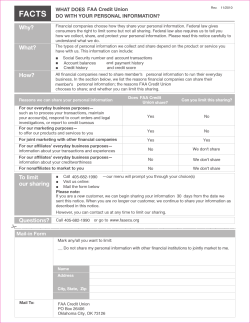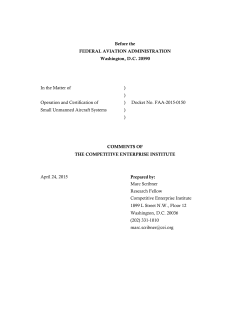
Comments - Aeronautical Repair Station Association
121 North Henry Street Alexandria, VA 22314-2903 T: 703 739 9543 F: 703 739 9488 arsa@arsa.org www.arsa.org April 23, 2015 Delivered via electronic submission: www.regulations.gov Docket Operations, M-30 U.S. Department of Transportation (DOT) 1200 New Jersey Avenue SE, Room W12-140 West Building Ground Floor Washington, DC 20590-0001 Re: Comments to Docket No. FAA-2015-0150-0017 Operation and Certification of Small Unmanned Aircraft Systems To Whom It May Concern: The Aeronautical Repair Station Association (ARSA) respectfully submits its comments to the above referenced notice of proposed rulemaking (NPRM). ARSA represents the aviation maintenance industry; its members include aircraft operators, aviation maintenance facilities and individuals certificated by the Federal Aviation Administration (FAA). As FAA-certificated entities, ARSA members are significantly impacted by any diversion of already-scarce agency resources. ARSA shares the FAA’s desire to “enable integration of [small unmanned aircraft systems (sUAS)] into the [National Airspace System (NAS)] in a manner that does not impose unacceptable risk to other aircraft, people, or property.” However, the association advises the agency to minimize any burden on the existing aviation industry and ensure the government has the resources necessary to enforce the proposed requirements. While ARSA understands the congressional directive for the FAA to integrate sUAS into the NAS, the association favors adoption of the simplest regulatory scheme possible. In regulating sUAS and, eventually, all UAS operations, the FAA cannot afford to divert attention from its existing oversight responsibilities. Additionally, the agency must limit burden on small businesses and prevent obstruction of the fast-moving market for emerging unmanned technologies. The association strongly encourages the agency to adhere to the following principles in the promulgation of any final rule regarding sUAS. April 23, 2015 Page 2 Re: Comments to Docket No. FAA-2015-0150-0017 Operation and Certification of Small Unmanned Aircraft Systems (I) Properly manage resources. The FAA is acting under congressional mandate to establish “requirements for the safe operation of such [unmanned] aircraft systems in the national airspace system.”1 However, the agency already struggles to efficiently administer existing congressionallymandated certification and inspection processes. As one example, the current waiting time to obtain a new repair station certificate can reach two years – a symptom of an already-overworked certification system. Selfimposing unnecessary burden through overly-complex regulation of sUAS will negatively impact current users of the NAS, resulting in administrative delays and undermining safety as well as the U.S. aviation industry’s growth. (II) Minimize the impact on small businesses. Of the more than 4,000 FAA-certificated repair stations in the United States, 84 percent qualify as small-to-medium-sized enterprises. That’s nearly 3,400 businesses that employ fewer than 50 people.2 These companies, and their partners in every corner of the industry, are the backbone of American aviation. As they compete in a global market, they are highly sensitive to the burden and costs associated with administrative delays. During a 2014 hearing of the United States House of Representatives Committee on Small Business, a witness (and owner of an independent aircraft services company in Hagerstown, Maryland), described how agency over-involvement encumbers private industry, particularly when dealing with new technology: The FAA routinely finds its hands tied by existing regulations when it wants to encourage the adoption of newer technologies and practices that could enhance safety. In many instances, the regulations have evolved in a way that forces the FAA to go well beyond its role as regulator and become directly involved with the operational aspects of the industry. 3 (Emphasis added.) The agency must ensure new administrative burdens from the final rule will not detrimentally impact current certificate holders who already require government services for certifications and approvals to keep their businesses viable. 1 FAA Modernization and Reform Act of 2012, Public Law 112-95, section 333(c). 2015 Global Fleet & MRO Market Economic Assessment. CAVOK. March, 2015. Available: http://arsa.org/news-media/economic-data/. 3 Hearing of the House Committee on Small Business, “The FAA’s Impact on Small Businesses in the General Aviation Industry.” February 5, 2014. Available: http://smallbusiness.house.gov/calendar/eventsingle.aspx?EventID=364942 2 April 23, 2015 Page 3 Re: Comments to Docket No. FAA-2015-0150-0017 Operation and Certification of Small Unmanned Aircraft Systems (III) Refrain from micromanagement. The FAA’s mission is to ensure aviation safety, but micromanagement and wanton regulatory complexity detracts from safety by diverting resources from legitimate administration and enforcement. Specifically in dealing with sUAS, where the private market is rapidly evolving and today’s advancement is tomorrow’s obsolescence, an over-involved agency will put both itself and its certificate holders behind. (IV) Conclusion As representatives of the aviation maintenance industry and members of the aviation community at large, ARSA’s members are committed to safety. To this end, the association shares the FAA’s responsibility to ensure the reasonable application of regulatory requirements in a way that minimizes burden on private business and prevents drag in the fast-moving aviation marketplace. In this matter, the agency should create simple, clear rules regarding the operation of sUAS within specific airspace without resorting to complex requirements that will take precious resources to enforce. Sincerely, Brett Levanto Operations Director Aeronautical Repair Station Association 121 North Henry Street Alexandria, VA 22314-2903 T: 703 739 9543 F: 703 739 9488 E: brett.levanto@arsa.org W: www.arsa.org
© Copyright 2025













